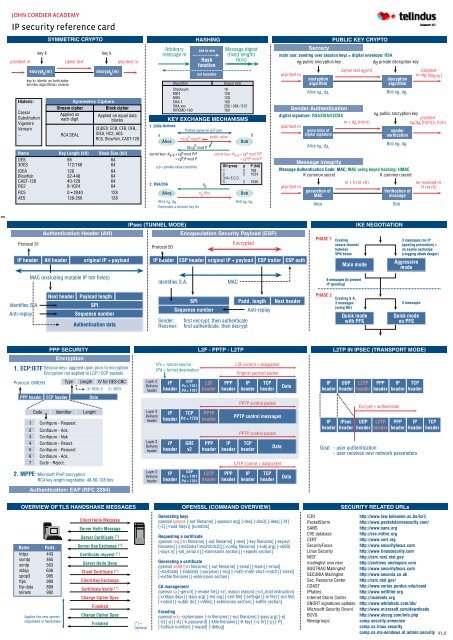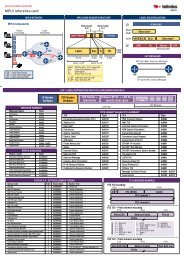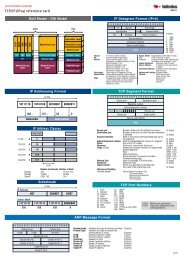IP security reference card - John Cordier Academy
IP security reference card - John Cordier Academy
IP security reference card - John Cordier Academy
You also want an ePaper? Increase the reach of your titles
YUMPU automatically turns print PDFs into web optimized ePapers that Google loves.
JOHN CORDIER ACADEMY<br />
<strong>IP</strong> <strong>security</strong> <strong>reference</strong> <strong>card</strong><br />
SYMMETRIC CRYPTO<br />
key k key k<br />
plaintext m cipher text plaintext m<br />
Historic:<br />
encrypt k (m)<br />
key k= identic on both sides<br />
enc/dec algorithms= inverse<br />
Caesar<br />
Substitution<br />
Vigenère<br />
Vernam<br />
...<br />
decrypt k (m)<br />
Symmetric Ciphers<br />
Stream cipher Block cipher<br />
Applied on<br />
each digit<br />
RC4.SEAL<br />
Applied on equal data<br />
blocks<br />
(3)DES: ECB, CFB, OFB,..<br />
IDEA, RC2, AES<br />
RC5, Blowfish, CAST-128<br />
Name Key Length (bit) Block Size (bit)<br />
DES 56 64<br />
3DES 112/168 64<br />
IDEA 128 64<br />
Blowfish 32-448 64<br />
CAST-128 40-128 64<br />
RC2 8-1024 64<br />
RC5 0➛2040 128<br />
AES 128-256 128<br />
Protocol 51<br />
<strong>IP</strong> header<br />
Identifies S.A.<br />
Anti-replay<br />
Authentication Header (AH)<br />
AH header original <strong>IP</strong> + payload<br />
MAC (excluding mutable <strong>IP</strong> hdr fields)<br />
Next header Payload length<br />
PPP SECURITY<br />
SPI<br />
Sequence number<br />
Authentication data<br />
1. ECP:IETF Session key= aggreed upon prior to encryption<br />
Encryption not applied to LCP / ECP packets<br />
Protocol: 0X8053<br />
PPP header ECP header Data<br />
Code Identifier Lenght<br />
1 Configure - Request.<br />
2 Configure - Ack.<br />
3 Configure - Nak<br />
4 Configure - Reject.<br />
5 Configure - Request.<br />
6 Configure - Ack.<br />
7 Code - Reject.<br />
2. MPPE: Microsoft PtoP encryption:<br />
RC4 key length negotiable: 40-56-128 bits<br />
Arbitrary<br />
message m<br />
1. Diffie-Hellman<br />
HASHING<br />
one to one<br />
Hash<br />
function<br />
not feasable<br />
Message digest<br />
(fixed length)<br />
H(m)<br />
Checksum 16<br />
MD4 128<br />
MD5 128<br />
SHA-1 160<br />
SHA-xxx 256 / 384 / 512<br />
R<strong>IP</strong>EMD-160 160<br />
KEY EXCHANGE MECHANISMS<br />
Parties agree on g-P pair<br />
Alice<br />
h1=g<br />
Bob<br />
a a<br />
mod P<br />
public value<br />
b<br />
h2=g b mod P<br />
secret key= Ka-b = (gb mod P) a<br />
= (gb ) a mod P<br />
a,b = private value (random)<br />
2. RSA/DSA<br />
e b<br />
DH group g P (bit)<br />
1 2 768<br />
2 2 1024<br />
3/4= E.C.C.<br />
5 2 1536<br />
Alice e (Ks)<br />
b Bob<br />
Alice e A , d A<br />
Generates a session key Ks<br />
<strong>IP</strong>sec (TUNNEL MODE)<br />
Layer 2<br />
Delivery<br />
header<br />
Layer 2<br />
Delivery<br />
header<br />
Layer 2<br />
Delivery<br />
header<br />
Layer 2<br />
Delivery<br />
header<br />
Protocol 50<br />
<strong>IP</strong> header<br />
Identifies S.A.<br />
Bob e B , d B<br />
Encapsulation Security Payload (ESP)<br />
Encrypted<br />
plaintext m<br />
PUBLIC KEY CRYPTO<br />
main use: sending over session keys = digital envelope: RSA<br />
eB public encryption key dB private decryption key<br />
encryption<br />
algorithm<br />
Alice eA, dA<br />
cipher text eB(m)<br />
decryption<br />
algorithm<br />
Bob eB, dB<br />
plaintext<br />
m=dB [eB(m)]<br />
Sender Authentication<br />
digital signature: RSA/DSA/ECDSA<br />
eA public encryption key<br />
plaintext<br />
m + dA (h(m))<br />
eA(dA [h(m)]= h(m)<br />
plaintext m<br />
generation of<br />
sender<br />
digital signature<br />
verification<br />
plaintext m<br />
ESP header original <strong>IP</strong> + payload ESP trailer ESP auth<br />
SPI<br />
MAC<br />
Padd. length Next header<br />
Sequence number Anti-replay<br />
Sender: first encrypt, then authenticate<br />
Receiver: first authenticate, then decrypt<br />
<strong>IP</strong>s = tunnel source<br />
<strong>IP</strong>d = tunnel destination<br />
<strong>IP</strong><br />
header<br />
<strong>IP</strong><br />
header<br />
<strong>IP</strong><br />
header<br />
<strong>IP</strong><br />
header<br />
UDP<br />
Ps = 1701<br />
Pd = 1701<br />
TCP<br />
Pd = 1723<br />
GRE<br />
v2<br />
UDP<br />
Ps = 1701<br />
Pd = 1701<br />
L2F - PPTP - L2TP<br />
L2F<br />
header<br />
PPTP<br />
header<br />
PPP<br />
header<br />
L2TP<br />
header<br />
PPP<br />
header<br />
<strong>IP</strong><br />
header<br />
PPP<br />
header<br />
L2F control + datapacket<br />
Original payload packet<br />
<strong>IP</strong><br />
header<br />
TCP<br />
header<br />
PPTP control packet<br />
PPTP control messages<br />
PPTP control packet<br />
TCP<br />
header<br />
Data<br />
L2TP control + datapacket<br />
<strong>IP</strong><br />
header<br />
TCP<br />
header<br />
Alice eA, dA<br />
m + h (m +K)<br />
Bob eB, dB<br />
Message Authentication Code: MAC; MAC using keyed hashing: HMAC<br />
K common secret K common secret<br />
Data<br />
Data<br />
generation of<br />
MAC<br />
Verification of<br />
message<br />
Alice Bob<br />
PHASE 1 Creating<br />
secure channel<br />
between<br />
VPN boxes<br />
PHASE 2<br />
Main mode<br />
6 messages (to prevent<br />
<strong>IP</strong> spoofing)<br />
<strong>IP</strong><br />
header<br />
<strong>IP</strong><br />
header<br />
Creating S.A.<br />
3 messages<br />
(using DH)<br />
Quick mode<br />
with PFS<br />
IKE NEGOTIATION<br />
Aggressive<br />
mode<br />
on received m:<br />
H (m+K)<br />
3 messages (no <strong>IP</strong><br />
spoofing prevention) =<br />
no cookie exchange<br />
(clogging attack danger)<br />
3 messages<br />
Quick mode<br />
no PFS<br />
L2TP IN <strong>IP</strong>SEC (TRANSPORT MODE)<br />
UDP<br />
header<br />
<strong>IP</strong>sec<br />
header<br />
L2TP<br />
header<br />
UDP<br />
header<br />
PPP<br />
header<br />
L2TP<br />
header<br />
<strong>IP</strong><br />
header<br />
Encrypt + authenticate<br />
OVERVIEW OF TLS HANDSHAKE MESSAGES OPENSSL (COMMAND OVERVIEW) SECURITY RELATED URLs<br />
Name Ports<br />
https 443<br />
ssmtp 465<br />
snntp 563<br />
sldap 636<br />
spop3 995<br />
ftps 990<br />
ftp-data 889<br />
telnets 992<br />
Applies the new secrets<br />
negotiated in handshake<br />
Encryption<br />
Type Length IV for DES-CBC<br />
3= DESv 2 2= 3DES<br />
Authentication: EAP (RFC 2284)<br />
Client Hello Message<br />
Server Hello Message<br />
Server Certificate (*)<br />
Server Key Exchange (*)<br />
Certificate request (*)<br />
Server Hello Done<br />
Client Certificate (*)<br />
Client Key Exchange<br />
Certificate Verify (*)<br />
Change Cipher Spec<br />
Finished<br />
Change Cipher Spec<br />
Finished<br />
(*) =<br />
Optional<br />
Algorithm Output (bit)<br />
secret key= K b-a = (g a mod P) b<br />
= (g a ) b mod P<br />
Generating keys<br />
openssl genrsa [-out filename] [-passout arg] [-des] [-des3] [-idea] [-f4]<br />
[-3] [-rand file(s)] [numbits]<br />
Requesting a certificate<br />
openssl req [-in filename] [-out filename] [-new] [-key filename] [-keyout<br />
filename] [-[md5|sha1|md2|mdc2]] [-config filename] [-subj arg] [-x509]<br />
[-days n] [-set_serial n] [-extensions section] [-reqexts section]<br />
Generating a certificate<br />
openssl x509 [-in filename] [-out filename] [-serial] [-hash] [-email]<br />
[-startdate] [-enddate] [-purpose] [-req] [-md2|-md5|-sha1|-mdc2] [-clrext]<br />
[-extfile filename] [-extensions section]<br />
CA management<br />
openssl ca [-gencrl] [-revoke file] [-crl_reason reason] [-crl_hold instruction]<br />
[-crldays days] [-days arg] [-md arg] [-cert file] [-selfsign] [-in file] [-out file]<br />
[-notext] [-outdir dir] [-infiles] [-extensions section] [-extfile section]<br />
Encoding<br />
openssl enc -ciphername [-in filename] [-out filename] [-pass arg] [-e]<br />
[-d] [-a] [-A] [-k password] [-kfile filename] [-K key] [-iv IV] [-p] [-P]<br />
[-bufsize number] [-nopad] [-debug]<br />
Secrecy<br />
Message integrity<br />
PPP<br />
header<br />
TCP<br />
header<br />
<strong>IP</strong><br />
header<br />
Goal: - user authentication<br />
- user receives new network parameters<br />
TCP<br />
header<br />
ICRI http://www.law.kuleuven.ac.be/icri/<br />
PacketStorm http://www.packetstorm<strong>security</strong>.com/<br />
SANS http://www.sans.org<br />
CVE database http://cve.mittre.org<br />
CERT http://www.cert.org<br />
SecurityFocus http://www.<strong>security</strong>focus.com<br />
Linux Security http://www.linux<strong>security</strong>.com<br />
NIST http://csrc.ncsl.nist.gov<br />
mailinglist overview http://archives.neohapsis.com<br />
BUGTRAQ Mailinglist http://www.<strong>security</strong>focus.com<br />
SECUNIA Mailinglist http://www.secunia.co.uk<br />
Sec. Resource Center http://csrc.nist.gov/<br />
COAST http://www.cerias.purdue.edu/coast<br />
<strong>IP</strong>tables http://www.netfilter.org<br />
Internet Storm Center http://incidents.org<br />
SNORT signatures updates http://www.whitehats.com/ids/<br />
Microsoft Security Downl. http://www.microsoft.com/downloads<br />
BCVG http://www.ebcug.com/info.php<br />
Newsgroups comp.<strong>security</strong>.announce<br />
comp.os.linux.<strong>security</strong><br />
comp.os.ms-windows.nt.admin.<strong>security</strong><br />
V1.0
NETWORK ADDRESS TRANSLATION (NAT) ONLY<br />
Source <strong>IP</strong> 10.1.10.5 Dest. <strong>IP</strong> 1.30.5.9 Source Port 5500 Dest. Port 80<br />
Source <strong>IP</strong> 1.30.5.9 Dest. <strong>IP</strong> 10.1.10.5 Source Port 80 Dest. Port 5500<br />
Source <strong>IP</strong> 10.1.10.5 Dest. <strong>IP</strong> 1.30.5.9 Source Port 5500 Dest. Port 80<br />
Source <strong>IP</strong> 10.1.10.6 Dest. <strong>IP</strong> 1.30.5.9 Source Port 5500 Dest. Port 80<br />
Source <strong>IP</strong> 1.30.5.9 Dest. <strong>IP</strong> 10.1.10.16 Source Port 9483 Dest. Port 22<br />
Source <strong>IP</strong> 1.30.5.9 Dest. <strong>IP</strong> 10.1.10.17 Source Port 5098 Dest. Port 80<br />
INTERNAL EXTERNAL<br />
Source <strong>IP</strong> 10.1.10.5 Dest. <strong>IP</strong> 1.30.5.9 Source Port 5500 Dest. Port 80 Source <strong>IP</strong> 2.2.2.5 Dest. <strong>IP</strong> 1.30.5.9 Source Port 5500 Dest. Port 80<br />
Source <strong>IP</strong> 1.30.5.9 Dest. <strong>IP</strong> 10.1.10.5 Source Port 80 Dest. Port 5500 Source <strong>IP</strong> 1.30.5.9 Dest. <strong>IP</strong> 2.2.2.5 Source Port 80 Dest. Port 5500<br />
STATIC SOURCE/DESTINATION MAPPING<br />
- Static Source Mode NAT (1-1): Checkpoint<br />
- Static Destination Mode NAT (1-1): Checkpoint<br />
- Mapped <strong>IP</strong>: Netscreen<br />
Source <strong>IP</strong> 1.30.5.9 Dest. <strong>IP</strong> 2.2.2.15 Source Port 5500 Dest. Port 80<br />
Source <strong>IP</strong> 2.2.2.15 Dest. <strong>IP</strong> 1.30.5.9 Source Port 80 Dest. Port 5500<br />
MULT<strong>IP</strong>LE ADDRESSES TRANSLATED TO A POOL OF ADDRESSES<br />
- Cisco: Static NAT<br />
- Netscreen: D<strong>IP</strong><br />
- Linux: SNAT<br />
NETWORK ADDRESS & PORT TRANSLATION<br />
Linux: masquerading<br />
Checkpoint: dynamic NAT/Hide Mode NAT<br />
Netscreen: NAPT<br />
Cisco: overloading<br />
10.1.10.5<br />
Signed<br />
By<br />
issuer<br />
Version = 3<br />
Serial Number<br />
Algorithm Identifier (1)<br />
Issuer (2)<br />
Period of Validity<br />
Subject (3)<br />
Subject’s Public Key (4)<br />
Issuer Unique ID<br />
Subject Unique ID<br />
Extensions (5)<br />
Signature<br />
PORT FORWARDING<br />
(ssh) 10.1.10.16<br />
X509 v3 CERTIFICATE<br />
10.1.10.1 2.2.2.5<br />
10.1.10.5 1.30.5.9<br />
10.1.10.5 (Web)<br />
(1) O.ID for Digital signatures:<br />
DSS SHA 2.16.840.1.101.22.1.1<br />
RSA MD5 1.2.840.113549.1.1<br />
(2) X.500 name (dn)<br />
(3) X.500 name (dn) & email address<br />
for rootCA-cert: issuer = subject<br />
(4) Public Key Algorithm: rsaEncryption<br />
RSA - Public Key: (1024 bit)<br />
- Modulus (1024 bit): .......<br />
- Exponent: 65537 (0x10001) or 3<br />
(5) Critical / non-critical<br />
- Extensions to support CP’s<br />
- Basic constraints extension<br />
- Policy Mapping extension<br />
- Policy Constraints extension<br />
- Private extensions<br />
- Extension to support indirect CRL<br />
- Extension to support cert-chain building<br />
2.2.2.15: static dest. address<br />
INTERNAL EXTERNAL<br />
POOL: 2.2.2.1 - 2.2.1.4<br />
INTERNAL EXTERNAL<br />
INTERNAL EXTERNAL<br />
2.2.2.6: port forwarding address<br />
INTERNAL EXTERNAL<br />
Private <strong>IP</strong><br />
10.1.10.5<br />
Mapped <strong>IP</strong><br />
2.2.2.15<br />
Dest. <strong>IP</strong> 1.30.5.9 Dest. <strong>IP</strong> 10.1.10.5 Source Port 5500 Dest. Port 80<br />
Source <strong>IP</strong> 10.1.10.5 Dest. <strong>IP</strong> 1.30.5.9 Source Port 80 Dest. Port 5500<br />
NAT Device Internal Mappings<br />
Private <strong>IP</strong> Translated <strong>IP</strong> Original Port Translated Port<br />
10.1.10.5 2.2.2.1 5500 2013<br />
10.1.10.6 2.2.2.2 6600 6600<br />
Source <strong>IP</strong> 2.2.2.1 Dest. <strong>IP</strong> 1.30.5.9 Source Port 2013 Dest. Port 80<br />
Source <strong>IP</strong> 1.30.5.9 Dest. <strong>IP</strong> 2.2.2.1 Source Port 80 Dest. Port 2013<br />
Source <strong>IP</strong> 2.2.2.5 Dest. <strong>IP</strong> 1.30.5.9 Source Port 2013 Dest. Port 80<br />
Source <strong>IP</strong> 2.2.2.5 Dest. <strong>IP</strong> 1.30.5.9 Source Port 4013 Dest. Port 80<br />
NAT Device Internal Mappings<br />
Mapped to <strong>IP</strong> Virtual <strong>IP</strong> Virtual Port Mapped to<br />
10.1.10.16 2.2.2.6 22 22 SSH<br />
10.1.10.17 2.2.2.6 8080 80 HTTP<br />
Source <strong>IP</strong> 1.30.5.9 Dest. <strong>IP</strong> 2.2.2.6 Source Port 9483 Dest. Port 22<br />
Source <strong>IP</strong> 1.30.5.9 Dest. <strong>IP</strong> 2.2.2.6 Source Port 5098 Dest. Port 80<br />
Signed<br />
By<br />
issuer<br />
1.30.5.9<br />
10.1.10.1 2.2.2.5<br />
10.1.10.5 1.30.5.9 (Web)<br />
10.1.10.6<br />
(web) 10.1.10.17<br />
10.1.10.1<br />
2.2.2.5<br />
10.1.10.1 2.2.2.5<br />
10.1.10.1 2.2.2.5<br />
1.30.5.9<br />
1.30.5.9<br />
Version<br />
Signature (1)<br />
Issuer (2)<br />
This update<br />
Next update<br />
List of revoked certs (3)<br />
...<br />
...<br />
...<br />
Extensions (4)<br />
Signature<br />
Private <strong>IP</strong><br />
10.1.10.5<br />
NAT Device Internal Mappings<br />
Dest. <strong>IP</strong><br />
1.30.5.9<br />
NAT Device Internal Mappings<br />
NAT Device Internal Mappings<br />
Private <strong>IP</strong> Original Port Translated Port Dest. Port<br />
10.1.10.5 5500 2013 80<br />
10.1.10.6 5500 4013 80<br />
X509 CRL FORMAT<br />
Dest. Port<br />
80<br />
Dest. Port<br />
80<br />
(1) Algorithm ID (eg HMAC-MD5)<br />
(2) Distinguished name of issuer<br />
(3) Contains entries:<br />
For every entry:<br />
- Cert serial number<br />
- Revocation date/time<br />
- Optional: Per entry extensions<br />
(4) Per CRL extensions<br />
Per Entry: Reason code<br />
Per CRL: - Authority Key Identifier<br />
- Issuer Alternative Name<br />
- CRL serial nr<br />
- Issuing Distribution Point (indirect CRL)<br />
- Delta CRL Indicator<br />
Source Port<br />
5500<br />
Dest. Port<br />
80<br />
80<br />
JOHN CORDIER ACADEMY<br />
www.jcacademy.com<br />
<strong>IP</strong> Security<br />
<strong>reference</strong> <strong>card</strong> © v.2.0





